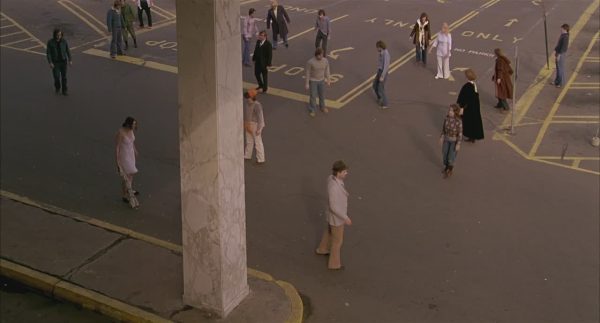The German filmmaker Ulrike Ottinger has on three different occasions put the camera aside and directed for the theatre, each time another a play by Nobel Prize laureate Elfriede Jelinek. In 2010 they embarked on another kind of collaboration as Jelinek began contributing to the dialogues in the screenplay of Ottinger’s film project Die Blutgräfin (The Blood Countess). While the reasons for each artist to address undeath are as varied or polymorphous as the range and style of their oeuvres, a direct connection in Jelinek’s case to her 1995 ‘Gothic novel’ The Children of the Dead (Die Kinder der Toten) is doubled by her own conviction, ever since its publication, that this work was her masterpiece, her posthumously-addressed legacy. And yet it was received by its first readership as a timely diagnostic encounter with the rise of right-wing politics in Austria.
In allegorical work, as Walter Benjamin pointed out, the first layer of figuration and exegesis is wrapped around topical significance. The Children of the Dead allegorises prefab Austria, in its own media reflection and echo, as a new youth culture that doesn’t need mass media now that it gets around as zombieism. Against the reign of prosperous postmodernity in Austria since the mid-1980s, Jelinek’s novel is set on an uncanny continuity, symptomatised as zombie epidemic, with the postwar Austrian ego idyll of decontextualised fascism and denial of the Holocaust dead.
‘I Was There’ when the post-war era lingered, malingered on. An excellent document of Vienna at the time I spent a year there is Valie Export’s movie Unsichtbare Gegner (Invisible Adversaries). It was the season right before the antifreeze content of Austrian wine was disclosed [Editor’s Note: a 1985 scandal in which it was revealed that some Austrian vineyards had been adulterating their product with diethylene glycol]. In the late afternoon on a daily basis you encountered at every turn individuals throwing up and passing out in the streets. Behind the counter at the local post office (where older women, so-called war widows, would ask for stamps for ‘Groß Deutschland’) sat a dwarf whose object of contemplation, the latest calculator gadget, was handcuffed to his wrist. To register at the university, you signed at one table, then again at another table down the hall in line of sight of the first registration. It was an arrangement for the authentication of signatures that conformed more to the layout of a Baroque garden than to a more modern regimen of proof. For my prolonged cold symptoms I was sent to the outskirts with pilgrimage crowds for treatment in a vast hospital, in my case (or in the corner in which I occupied a gurney) by means of the UV ray contraption strapped to my head. It is not so much that everything was outdated, ‘Eastern Bloc’. It was rather that Vienna seemed to carry forward the declining aspects and even the abrupt endings of eras long gone without any integration at these edges. One drawback was that where the ghouls were there was small chance of losing or finding anything contemporary.
Jelinek’s novel and Ottinger’s screenplay treat Austria and Vienna respectively as ready-made for alle-gory and allegorical reflection. The Children of the Dead is immersed in the date marks and brand names of its scene of writing. The Blood Countess visits contemporary sites in Vienna as specific to the Baroque funereal traditions that also pass through The Children of the Dead in juxtapositions or jump cuts reminiscent of their staging in Benjamin’s Origin of the German Mourning Play. According to Benjamin, allegorical signification on the Baroque stage begins upon a body’s lapse into lifelessness. Variations on undeath follow from this driving momentum of alle-gory.
Beginning with its topical administrations, The Children of the Dead enters the doubling of the allegorical ready-made as set forth by Benjamin: the corpse as instant emblem on the Baroque stage was followed in the world according to Baudelaire by the commodity, which supplied new contexts for allegorisation. What remains legible to the allegorist, then, is that the corpse is carried forward in the commodity and its media-technological milieu. Because a trace memory of what they loved doing best persists in their posthumous consumerism of living flesh in George Romero’s Dawn of the Dead (1978), the living dead keep congregating in the abandoned mass-culture shopping malls, shopping though they have dropped dead. Jelinek’s undead, who are also on average mid-life, keep going as psychopathic teens-at-heart, endlessly engaging in sports and date rape.
Hannah Arendt opens On Violence with the ‘technical development of the implements of violence’ that by the end of the Second World War guaranteed that warfare had lost its effectiveness as well as its political significance. The technological revolution that was aided by warfare as its medium outran and neutralised it. For D. W. Winnicott, as spelled out in his 1963 article ‘Struggling through the Doldrums’, the Second World War led to the introduction of deregulated adolescent energy as the brand new – yet highly unstable – medium for societal inoculation against and containment of violence. The teen was sent to this tight corner by the atom bomb that was dropped on war as we knew it. Together with the withdrawal of the rationalisation for discipline as preparation for war, the introduction of effective contraception meant that the post-war teen began containing himself as society’s site or medium of sex and violence. ‘Adolescence now has to contain itself, to contain itself in a way it has never had to do before.’
In ‘Contemporary Concepts of Adolescent Development and their Implications for Higher Education’, Winnicott advises parents to confront teens in a way that promotes ‘containment that is non-retaliatory’. But most important is that parental guidance as target of death wishes not abandon the attempt to integrate the teen in the family setting. It’s cheating at the ‘life-game” to ‘abdicate just as they come to kill you’. ‘Lost is all the imaginative activity and striving of immaturity. Rebellion no longer makes sense, and the adolescent who wins too early is caught in his own trap, must turn dictator, and must stand up waiting to be killed – to be killed not by a new generation of his own children, but by siblings. Naturally, he seeks to control them’. According to Winnicott, National Socialism capitalised on this scenario by filling and fulfilling the position of society’s superego with the teenager, not as mascot but as the very embodiment of mass psychology. Contrary to the gadget-loving teen’s role as in-group expert or tester according to Benjamin’s forecast of globalisation, whereby mass psychology would come to be made over as group psychology, in Nazi Germany the adolescent body modelled and guaranteed the bond of which everyone partook in the Mass of culture, even the non-disposable, indisposed dead. In The Children of the Dead it is this body-based incorporation of youth that is taken to the limit as zombieism – as narcissistic crisis of uncanniness and as psychopathic thrill of the kill of the dead. Although the Nazis made history out of one pathology, Winnicott emphasises that adolescence as such is at the fork in development between integration and psychopathy, between group therapy and mass psychology.
Adolescence is, to a significant degree, a time-based version of psychopathy, certainly as regards understanding and treatment. Both conditions or concepts tend to signal a failure of interpretation. Winnicott nevertheless began making the phrase or phase of juvenile delinquency transitionally legible in case studies of children he nipped as budding psychopaths at the onset of their ‘antisocial tendencies’. His signature intervention, as underscored, for example, in ‘The Antisocial Tendency’, was to characterise the initial ‘nuisance behaviour’ as an expression of ‘hope’ that illuminates the ‘importance of the environment’. The etymology of ‘hope’ includes in the word’s Germanic prehistory (preserved to this day as verhoffen, in the German ‘language of hunters’), some senses of which Winnicott pursued with his clients at great length. In a word, ‘hope’ begins as the startle response to a sudden change in our environment, whereby we (humans and animals alike) take the moment of hesitation to try out in our minds a new next move. For Freud, this ability to reconsider a plan of action as trial offer was the crux of what he called reality testing, which he assigned with great emphasis to the work of mourning. As with original hoping, we test in and beyond the interruption of loss a new frontier between life and death.
In Romero’s Night of the Living Dead (1968) it is the opening with Barbara and Johnny’s visit to their father’s grave that frames the onset of the zombie crisis. Before we are given shelter in a sci-fi explanation, the crisis is identified on TV as ‘epidemic of mass murder’. The zombies are the deregulated dead. But they also reflect back psyches unable to think outside their own embodiment. Romero announced that the zombies are us. The prospect of overlap between zombies and vampires was introduced by Richard Matheson in I Am Legend, in which catastrophe sparks in the stricken place of mass death reanimation of the dead en masse as undead. Massified and mass-psychologised the vampire appears now as zombie, now as juvenile psychopath.
The language of The Children of the Dead carries through the deregulated metabolisation of the dead. Each sentence loses the momentum of its sense to multiple random senses generated by homonymic punning and literalisation. The sense, like every constituent part of the fiction, becomes appetitive and appetising, devours and is devoured by prefab language, from advertising slogans to the middlebrow-beat of our intake of culture. The disturbed relationship to the dead submits every corpus to what is passing through it: the reanimation and return of the dead as food that eats and as sexual objects that violate. We are faced with strong signs that proper interment, culturally coded in terms of the father’s death and legacy, has not taken hold in the novel’s sensorium as the inoculation and insurance policy against death as annihilation.
In the fiction of living death, commodification and consumerism are carried forward as intact but decaying. The intake of zombies, however, is regulated by the incest taboo recast as half-life, the sole souvenir in living death of reproductive sexuality, which was inherited from vampirism. While the undead tend to beset their family members, whether by the logic of mourning or the metonymy of consumption of the one you’re with, the feeding libido shuts down once the body they are consuming, whether as flesh or the blood, turns into another zombie or vampire. The outright genital sexuality with their peers that Jelinek projected as her counter-intuition for zombies or ghouls belongs, in the meantime, to the update of occult fiction. While it was formerly the work of interpretation alone that established the contact with vampires as repression and representation of genital sexuality, vampires in new fictions filling the mainstream have been proving themselves to be sexual beings in recognizable ways since around the onset of the new millennium. In other words, if vampires are perverted now, their perversion is a diversion still organised around the body standing genitally centred. Indeed, every occult figure has, in the meantime, been admitted as our sexual neighbour. In The Blood Countess, the sex appeal of vampirism, whether polymorphous or zom-bi, is that it is an open invitational that everyone wants to enter, though often as forget-together, as in our captive audience to media stars.
Between the lines of the interpersonal profile of the undead as perpetual teenager taking sex and violence to the limit, unto death and the dead, Jelinek advances another creaturely track, that of the critter. Both in its figuration and its language, The Children of the Dead advances on animal feet on the track less of sense than of something more compelling, like scent. The POV of and in this language has the motility of reality testing, which we share with animals as the basis for what is called thinking. As Melanie Klein demonstrated, reality testing, unbound by the protocols of ‘present and accounted for’, or ‘tried and true’, proceeds in or as mourning.
In the closing paragraph of the epilogue to The Children of the Dead, the basic language of relationality, the ‘and’ (‘und’), barks back as echo contained or released within the German word for ‘dog’, (‘hund’).
WIR SIND KEIN HUNDE-ÄUSSERLGEBIET? Nein, da steht, WIR SIND EIN UND ÄUSSERLGEBIET.
In the background of the directions taken here in the doubling flow of language is Jelinek’s identification, notably in her Nobel Prize acceptance speech, of her relationship to language and writing as totemically tied to the animal relation, for which the pet dog serves as mascot. What meets or crosses over in the untranslatable epitaph is: either we are not an off-leash area for dogs, or we are an in and out, on and off area, or we are an area in which the ‘And’ is free to move about.
What follows contact with the Hund/Und at the close of The Children of the Dead is the synching up of the death of Karin F. (who has been lying in intensive care throughout the course of the novel, which commenced with her traffic accident) with the mass extinction of tourists, locals, and ghosts or zombies in the closing mud slide. Her mother, who walked away unhurt from the earlier crash, dies buried alive in the ultimate catastrophe. It was Winnicott again, as Roland Barthes liked to recall, who saw in any anxiously anticipated ultimate catastrophe the displacement of the traumatic event of its occurrence in the recent past. In this direction or sense it is the mother’s death for which the epidemic of undeath was the wrap.
Hope—which in Winnicott’s reading of the antisocial tendency refers to our share, experimented with or experienced as reality testing, in the creaturely scratch and sniff of basic motility—was defined by Klein as always the hope to make reparation, to make amends and thus repair the safety of the inner world. This alignment with the mother’s death, given in passing as throwaway afterthought,was the lifeline that animal motility kept crossing as carrier of hope. The holding of this line, which its criss-crossing by animal reality testing also represents, is, in Klein’s reading of mourning, far more significant than the antibody service associated with the father. Without the good object, the first good contact with the mother, you’re dead. But with its internalisation, the good object sustains you if or when there’s nothing good any longer on the outside. Hence the internal relationship to the good object is our life line, which must be re-secured in the face of loss and deprivation on the outside. For Klein, therefore, mourning’s work is this shoring up of the inner world that each new actualized loss strikes at its foundational cornerstone, the good object, the Hund/Und.
In The Children of the Dead, then, we are under the duress of the attack upon the inner world. As the German phrase for reparation or restitution, Wiedergutmachung, inadvertently makes clear, the relationship to the good object, with which one must repeatedly renew vows, is what is threatened by the disavowal of the victims of Groß Deutschland. With regard to the Furies, who are given to prosecute matricide alone, Klein counters in ‘Some Thoughts on The Oresteia‘ that it is the height of denial to make a value distinction between these dead and those other dead, between these victims and the other ones. Everyone who dies in our midst is the mother. The distinction amounts, then, to denial in the sense that love is denied, withheld from the good object. It is the denial that Klein identified as crux of haunting that besets survivors from without as vengeful, complaining ghosts. To paraphrase the close of Kafka’s The Trial: killed off ‘like a dog’, or as an Und, it was as if the shame would outlive him. What outlives or lives through us is, in a word, shame, which like its German etymon, Scham, is tied to one of the words for corpus or corpse, Leichnam. As Und we hand it to the inner dead living through and outliving us. Split off from this infrastructure or intrapsychic significance, shame is the pathogen most closely allied with the narcissistic wounding and raging that extends to the afterlife.
While regular TV programming seems coextensive with the epidemic of mass murder as zombieism in Jelinek’s novel, in Ottinger’s The Blood Countess the big screen frames the projective encounter with finitude as vampirism. By placing Countess Bathory in charge, the maternal aspect of vampiric recycling of blood is openly admitted. It slips out in Bram Stoker’s Dracula when the Count, to install a telepathic connection to and through Mina Harker, must nurse her at his breast. In The Blood Countess, we follow Countess Bathory through Ottinger’s signature film world, which is ruled according to the noble system of valuation as elaborated both by Nietzsche and Klein. Leave good-enough alone: the good (breast) must be kept distinct from what is bad. The guardians of moral standards cry murder while the vampires pursue quarry that’s as good as gone. Bubi, the neurotic nephew of the Countess, struggles to reverse his vampirism by becoming a vegetarian, which would allow him, then, to demonise the kill as murder– in which he, however, collaborates. As his aunt counsels him, if Bubi cannot face the problem of food and death by killing and mourning, then he must climb up over the corpses of murder he leaves unburied and uncontained.
The Blood Countess does not add to the thrill of countless zombie films over killing the dead. To admit a host of pathogenic elisions more directly symptomatized as zombieism within its cinematic self-reflection, however, The Blood Countess revamps the vampiric condition as prey to forgetting. Countess Bathory returns from Hollywood to Central Europe following a summons received in her dreams from ancestors who warn of the threat of an ancient book. ‘To that end I must look for myself in the past and conduct rigorous research in my family history.’ Her search runs counter to the forgetting that besets the register of crime detection. When Chief Detective Unglaube lists the local bloodsucking serial crimes that he can remember we find there is a gap between 1924 and 1949. By the end, however, the Countess gets on the next flight back to Hollywood (and to her double life suspended between trance states on film sets and sessions of beauty sleep) because her past has become too real for her in Vienna. Countess Bathory faces and works through one kind of forgetting and affirms another kind as kinder – kinder to the dead. The Und is contained in The Blood Countess in the relationship to forgetting, which isn’t only an affliction, but at times takes precedence over remembering. The film withholds – and dis-re-members – a book that is rumored to have caused a general to forgo battle or even a vampire to weep and withdraw from the hunt.
In The Blood Countess, the book that, in bringing on the tears, allows the vampire to become ‘a common mortal’ is either unread or, if and when read, undone: over time the tears have composted it. What’s left the Countess Bathory commits to fire and gravity while she goes up in flight from the representatives of order. The destruction of the book that would give violence a rest in peace is the film’s affirmation of forgetting. In On Violence, Arendt took issue with the notion that the dehumanisation of concentration camp inmates meant that they were reduced to the animal state. The human qualities of which the inmates were deprived were notably rage and the violence that at times emerges as the only means of righting the scales of justice. That the deprivations Arendt stipulates are also imposed on animals at the stockyards is another way to remember that, fundamentally, the inmates were denied the UND of mourning rites/rights. The physical act of aggression, which is preceded by a gathering together of strength, a kind of self-collection, was Winnicott’s model for integration, which, as Klein stipulated upon introducing the term into the psychoanalytic lexicon, carries the metabolism of mourning forward through remembering or forgetting unto the vanishing point of irretrievable, unmournable loss.
We learn to remember by rote before we learn by remembering. As Nietzsche taught, in order to become promising animals a few prohibitions had to be burned into us. But we must also remember to forget. This is our defence contract with memory, which Benjamin found exemplified as the place and date marking that renders memories or souvenirs disposable. Ultimately, however, we must also remember that we will forget, will be forgotten, that forgetting will take over where remembrance leaves off. This is the ultimate and most difficult task of mourning, the acceptance of the finitude of remembrance. In The Blood Countess, vampirism holds the place of this ultimate forgetting in or as mourning – through which alone integration and affirmation of life is possible – and which agencies of order would replace with their controlling interests. The bite that’s on the vampirologists, therapists and police inspectors by the end of the screenplay is violence setting right the scale or size of the information byte to which teens and midlife critics, undead or live, reduce the other who comes from afar. The run of mourning cannot outlast this long distance of the other’s oblivion. Only in undeath is mourning’s epitaph legible and only in the span of its projections can we mourn, ultimately, over mourning itself.
share
ABOUT THE CONTRIBUTOR
Laurence Arthur Rickels is an American literary and media theorist. He is the author of The Case of California, The Vampire Lectures, and the three volume Nazi Psychoanalysis, among other works. His new book Germany: A Science Fiction is forthcoming in December 2014 with Anti-Œdipus Press. He is professor of Art and Theory at the Academy of Fine Arts, Karlsruhe.




